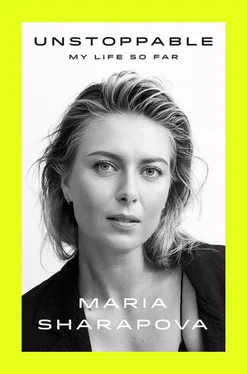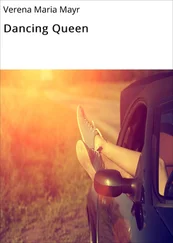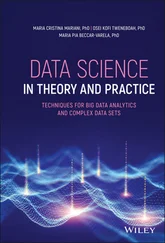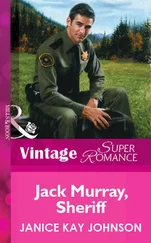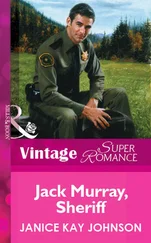I sat there, staring at my feet, taking in these words. I was twenty-one years old. At first, it did not register. I did not believe him. Later that night, when it did hit me, I fell into a kind of black hole. I’d finally made it, gotten my game and life just where I wanted it to be, and now I was going to lose everything because of one small split tendon? And what if my career did end there? How would I be remembered? As a flash in the pan, just another sad story, a cautionary tale? No. I refused to believe that this is how it would end.
* * *
I was in the hospital a few days later, prepped for surgery, and in that gown that has been in and out of the washing machine so many times. I went to New York with my mother, Max, and Michael Joyce, who’d now been coaching me for several years. I’ll never forget Max’s face. He was saying all the right things, and being encouraging and calm, and it’s no big deal, every player, and so forth and so on, but his eyes were red and it seemed to me that he’d been crying. He was so shaky that it made me shaky, but mostly I was touched. Max and I had been together for so long, been through so much. Without realizing it, we’d become family.
The details of the operation had been explained to me. I understood it on an intellectual level, but the thought of someone cutting into my shoulder and playing around with the ligaments and nerves was terrifying. It’s a big part of the makeup of any athlete—being in control. My serve, my plan, my game. And now, when it came to the most important game of all, I was giving up all control. A complete loss of autonomy. When the big plays were made, the plays that would affect my own body, I’d be less than a spectator. I’d be unconscious.
Here’s what bothered me most: various people, nurses and doctors, came into my room and asked me a question that had already been asked many times before. Which shoulder? Is it this one, or that one? Are you sure it’s not the left shoulder? I felt like saying, “Hey, have you ever watched a tennis match? Have you ever seen me serve? I serve with my right arm, my right shoulder! Which is why it broke down, which is why I’m here!” Finally, someone came in and drew a big X on my right shoulder with what looked like a Sharpie. An X surrounded by all kinds of helpful arrows. Operate here!
At some point, after they’d shot me up and wheeled me in, a man put in my IV… I was gone. When I opened my eyes, and it seemed like a moment later, my shoulder and arm were swaddled like a newborn baby and my thoughts were as thick as syrup and I was being wheeled down a long linoleum hallway. Fluorescent lights. The hum of rubber wheels. Then I was back in my hospital room, surrounded by three familiar faces. Thirty minutes later, I looked at Max and said, “I don’t belong here. Get me out of here.”
Then I sat up and, as I did, vomited all over the floor. It was from the anesthesia. I guess I wasn’t ready to leave the hospital yet, but that’s when I began my long journey back.
I started rehab in Arizona soon after. I did most of that work with Todd Ellenbecker, a specialist in shoulder recovery based outside Phoenix. I would fly to Arizona each Monday with Michael Joyce, then back to L.A. on Friday. Every week, on Monday and Friday, that same bag of peanuts on that same Southwest Airlines flight. I could have stayed in Arizona, but the work was hard and tedious and I don’t love living in a hotel, so I went back to L.A. each weekend.
We started with stretching and strength exercises. It was as if I had a brand-new shoulder, still stiff from bubble wrap and tape. I had to regain power and mobility. Of course, I had known about all this and was prepared. But what I was not prepared for, what took me by surprise, was the pain. The incredible pain. It hurt like hell to lift those little half-pound weights and do those little drills, but I could not rest and could not whine. It went on for days and days. And every day seemed the same. Hours of gray skies and bad moods and afternoon showers, and meanwhile the world was going on without me, the matches and the finals and the trophies raised at center court, all of it continuing as if my presence did not matter, as if I’d never been born. It was like being shut out of your own life, or locked out of your own house.
They brought in various trainers and strength coaches to work with me and still it hurt like hell and still the progress was slow. They’d cut me open in October 2008. I was back on the court, hitting balls (badly) by Christmas. But everything felt different, and by “different” I mean wrong. It hurt and was ugly. My strength was gone. My flexibility was gone. And my range of motion. When I tried to serve, I could not get my arm back far enough to generate any power. I would eventually learn to hit the ball again, to emerge from this pain and funk, but as a different player. I’d never have the same kind of serve that I’d had at seventeen. Not as consistent, not as free, not as loose. Not as powerful. Not as accurate. My motion had to be shortened. I knew that, but could still not get it quite right. I did not feel comfortable on the court, or in my body. What was I doing out there during all those miserable mornings in the winter of 2008? I was learning to play tennis again. I’d have to rely more on canniness and strategy. I’d have to rely less on my serve than on my return of serve. In some ways, I’d be a better player as a result. In other ways, I’d be worse. In either case, I had to learn to win in a new way.
My father set up a few practice matches. These did not go well. I lost to inferior players. It sent me into a kind of panicky moodiness. Nothing made me happy. I became obsessed with my shoulder, my future, my game. And did I mention my shoulder? It made it impossible for me to enjoy the other parts of my life—my friends and family, food, shopping, a sunny day.
My parents were worried about me. And so was Max. Not about my tennis—they claim they always knew that I’d find my way back—but about my spirit, my state of mind. Despite the large amount of support and love I received from people in my life, I felt so lonely and small. And nothing they said could make me feel any better. So I decided to resume my childhood habit of writing in a journal, putting my sad thoughts on paper. As days went by, that paper became my best friend, the only friend I could trust, the only friend I could share with.
It would be a crucial part of my recovery. I came to believe that the physical act of writing can reeducate your brain. By writing, you access certain thoughts and feelings that might otherwise remain hidden. You can bring them to the surface, where they can be understood and then dealt with. It’s like turning on a light in a dark room. What you had believed to be a monster is revealed in the light to be little more than shadows. Boom, you’re back to your old, less freaked-out self. I also came to believe that you can plant positive thoughts in your psyche in the same way. Put it on paper and in it goes. Which is why, if you look through those diaries, which I have saved and used to help write this book, you will see pages given over to nothing but positive phrases in the nature of “Yes, you can. Yes, you can. Yes, you can.” But mostly I am talking myself through my injury and frustration and pain.
A typical entry:
I am completely flustered! You see I can’t even write. It’s been God knows how long since I started (I believe eight weeks now) and I’m still all the way in the bottom of the ditch somewhere in the middle of America. Basically I don’t feel like my shoulder is getting any better. It’s a constant battle. I’m doing everything I can possibly do for it. Yet I constantly have a hollow feeling inside me. I know that it will get better and I am going to play and serve without any pain but I also feel like I’m fooling myself for no apparent reason. I walk into the clinic every single day and do what? Get stronger? Will that take the pain away? How long will it take? It’s these constant questions that I myself cannot answer.
Читать дальше
